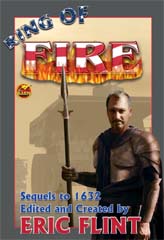
The stories in Ring of Fire are all based in the alternate history setting I created in my novel 1632, which was further developed in the sequel I wrote with David Weber, 1633.
Producing "spin-off" anthologies as part of a popular series has a long and venerable history in science fiction, of course. But, in at least two respects, this anthology is different from most such—and the two differences are related.
The first difference is obvious: It is very unusual to produce a shared-universe anthology when a "series" consists, so far, of only two novels. Doing so would seem premature, since the setting really isn't all that firmed up yet.
But that was exactly why I wanted to do it so early in the game—which leads me to the second difference:
In most shared-universe anthologies, as a rule, the stories are tangential to the main line of the story as developed in the creating author's own novels. They might be excellent stories, in their own right, but they rarely have much if any direct impact on the logic of developments in the series itself. The reason is simple. Authors are generally reluctant to have other authors shape their own setting, and the contributing authors to an anthology respect that and design their stories to be somewhat "off to the side." The stories are in the setting, but they do not really affect the setting very much.
That is not true of Ring of Fire. The stories in this anthology all feed directly into the development of the series as a whole. They are not simply part of it, they actively shape it.
Indeed, several of them have already done so. Many of these stories were written before Dave Weber and I wrote 1633, and we deliberately incorporated them into the plot of that novel. For example:
The characters of Tom Stone and his children, who appear in 1633 and will be major characters in the upcoming novel 1634: The Galileo Affair, are first introduced into the series by Mercedes Lackey in her story in this anthology, "To Dye For." (1634: The Galileo Affair is co-authored by me and Andrew Dennis, and will be published in April of 2004. Andrew is another of the authors in this anthology.)
The interaction between the Earl of Strafford and Dr. Harvey, which occurs in 1633, presupposes a prior visit to the time-transplanted town of Grantville. The story of that visit is told here, in S.L. Viehl's "A Matter of Consultation."
Dave Weber's story "In the Navy" provides the background for the creation of the new American navy, which was such a prominent part of 1633.
The character of Gerd, who appears in 1633 as one of Captain Harry Lefferts' men, is first introduced into the 1632 universe in Greg Donahue's "Skeletons."
* * *
A number of the other stories here lay the basis for future developments in the series. That is most clearly evident with my own story, the short novel The Wallenstein Gambit. The events depicted in that story will be central to most of the future volumes in the series. The story is not "on the side." It is right smack in the middle of the series as it continues to unfold.
Furthermore, the basis for The Wallenstein Gambit was, to a considerable degree, laid in this anthology by three other stories: Dave Freer's "A Lineman For the Country," Jody Dorsett's "The Three Rs," and (most directly) by K.D. Wentworth's "Here Comes Santa Claus."
Andrew Dennis' "Between the Armies" lays much of the basis for our forthcoming novel 1634: The Galileo Affair. (As does 1633, of course—the character of Sharon Nichols who figures prominently in 1633 is a major character in The Galileo Affair.) Some of the characters developed by Deann Allen and Mike Turner in their story "American Past Time" will also appear in The Galileo Affair.
Virginia DeMarce's "Biting Time" lays the basis for a novel which she and I are working on, which will both continue the story she began as well as link it to the story line I develop in The Wallenstein Gambit.
To one degree or another, that is true of every story in this anthology. Many of the characters you first encounter here will reappear in later volumes of the series—and sometimes as major characters in their own right.
* * *
I wanted to produce this kind of anthology early in the series because I wanted, as much as possible, to capture something which is usually missing in alternate history series:
History is complicated. It is not the story of a few people, it is the story of an immense number of people—each of them full individuals in their own right, each of them having their own greater or lesser impact on developments.
In the nature of things, fictional series—like biographies—tend to give the illusion that history marches more-or-less in lockstep with the actions of the main characters of the story. That's almost inevitable, given the very nature of narrative. But it is an illusion, and I wanted to avoid it as much as possible in the unfolding 1632 series.
Yes, Mike Stearns and Rebecca Abrabanel and Jeff Higgins and Gretchen Richter and the other major characters I created in 1632 will continue to be major characters in the series. But they are not Greek gods and goddesses. They are simply people—and what happens to them will, in the end, be deeply affected by the actions of a Jewish jeweler in Prague trying desperately to prevent one of the worst pogroms in history, a small town Catholic priest undergoing a crisis of conscience, and a woman in late middle age who simply decides to found a school.
And . . . enough. Welcome to the Ring of Fire.